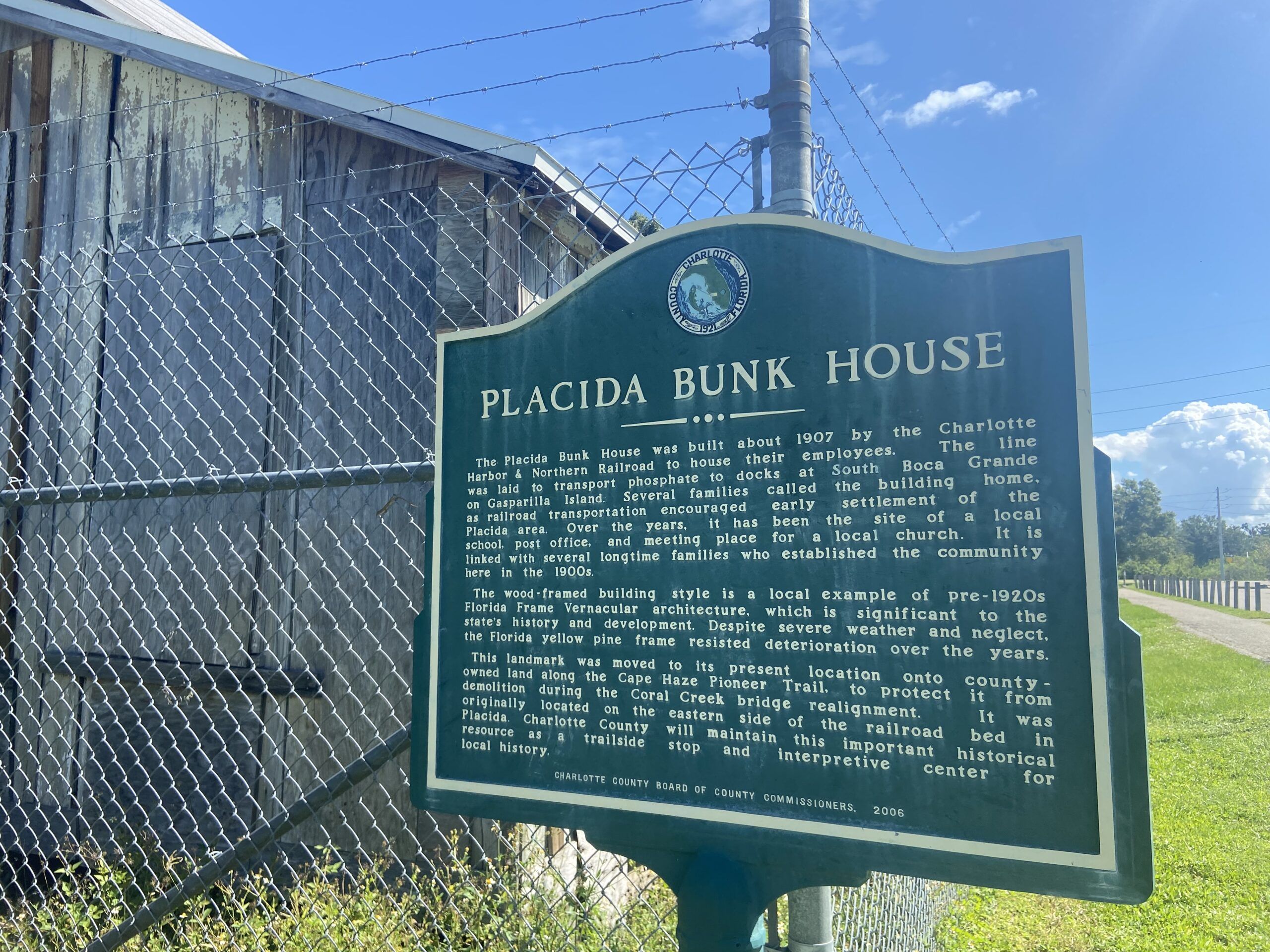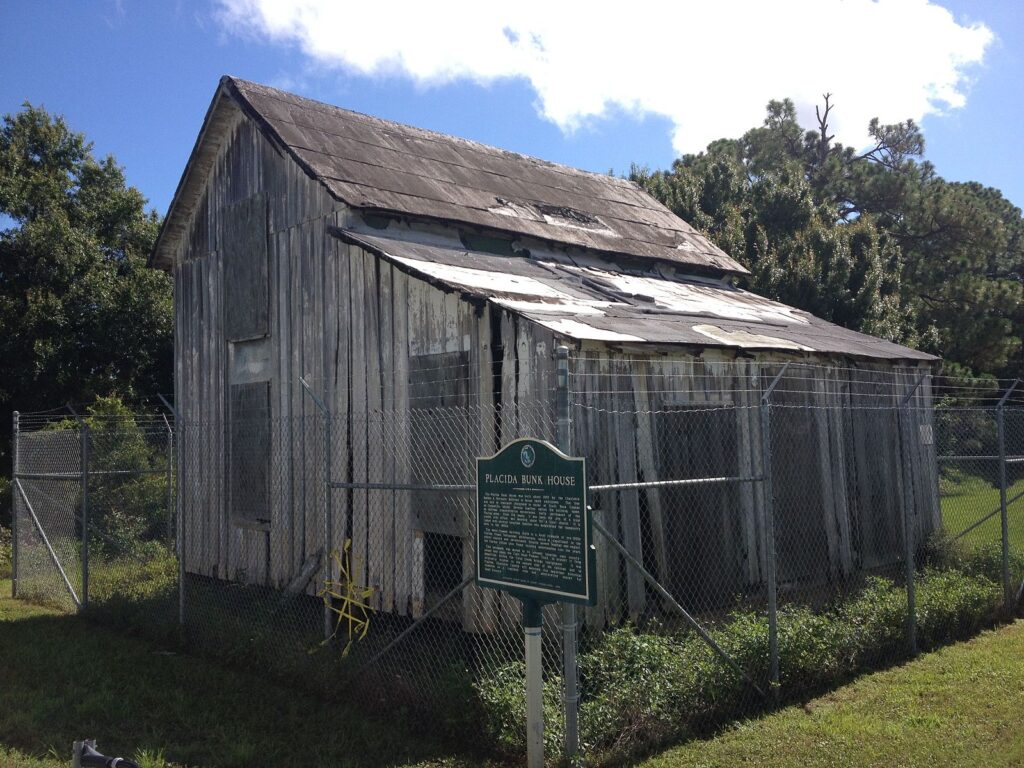Charlotte County Ponders Fate of Historic Placida Bunkhouse

A Charlotte County historic plaque makes a very clear promise about the Placida Bunkhouse, an old railroad dormitory that is currently resting and rotting behind the South Gulf Cove Publix off of Gasparilla Road.
The sign states:
“Charlotte County will maintain this important historical resource as a trailside stop and interpretive center for local history.”
However, a Placida resident, John Valickas, has raised the issue of the deterioration of the abandoned building, which dates from 1907, and is perhaps is among the oldest extant structures in Charlotte County.

“It’s will,” said Valickas of the sign, which is cast in steel. “It’s not may, or thinking about it.”
The Charlotte Harbor & Northern Railroad built the cottage to house its railroad workers sometime around 1907. It is currently deteriorating behind barbed wire at a county park.
“This thing is just sitting there rotting at the top of the trail,” said Valickas, who lives nearby on Coral Creek. He raised the issue to the Charlotte County commissioners, and on his Placida/Cape Haze memories Facebook page, which has over 5,400 members.
It was used in Placida by Walter Gault, who purchased the Gasparilla Fishery in 1938. It sat to the east of the railroad bed. A marker at the current site says that it is “linked with several longtime families who established the community here in the 1900s.”
Over the decades, the building has had a variety of uses, according to its marker, including as a church, a school and a post office. The county moved it to its current location when the bridge over Coral Creek was built. It remains the last remnant of the town of Placida, as well as the only remaining evidence of the fishing village at the north end of Gasparilla Island.
“It was a viable, beautiful fishery, and that was such a big part of it,” said Valickas.
The Placida train stop was not just a pass through; Seaboard Air Line offered Pullman service on its route to Boca Grande as well as bulk cargo at Port Boca Grande.
“Any other town in America would treasure their historic sites,” said Valickas. “I think it should be brought back to Placida.”
The building is of yellow pine and frame construction, and is of the Florida frame vernacular style, which is seen on cottages in Boca Grande and in old Englewood and across Florida. Since Valickas raised the issue, it has had a large number of comments in his Facebook group. Tommy Scott, community services director of Charlotte County, said in an email that the county is looking after the building.
“The county has taken protective measures on the bunkhouse location to prevent further damage to the structure,” wrote Scott. “At this time, the bunkhouse is not undergoing any active restoration, and no funding has been allocated to such work.”
Currently, the county has the building sitting next to the beginning of the Cape Haze Pioneer trail at the Dr. Robert and Ann Mercer Trailhead. Dr. Mercer, who had been founder of the Cleveland Clinic’s Department of Pediatrics, worked with his wife Ann to turn the abandoned railroad into a rail trail. The trail runs from the Gulf Cove park through Rotonda West, to connect with the Boca Grande Causeway. Its official end is by the Coral Creek Club, where there is parking and a bicycle maintenance station.
The county took control of the building after the purchase of the property needed for Coral Creek Bridge. For the construction of the bridge, the building was offered as an addendum to an April 2004 sale of the Gasparilla Fisheries property by Jacques Cloutier to Charlotte County. It read:
“The Parties acknowledge that an abandoned railroad bunkhouse building is located on Parcel ‘E,’ which building may be eligible for historic preservation designation. Cloutier agrees that for a period of one (1) year following the date of closing this transation, he will allow any person(s) to remove and relocate the railroad bunkhouse building at their sole cost and expenses for the purpose of preserving the building.”
The building is currently surrounded by weeds and is shielded from view by a chainlink fence. Its has a tarpaper roof, which is intact.
Commissioner Joe Tiseo of District 5 responded to Valickas by email, saying that the building was in very poor condition when they stabilized it for its move in 2005 and 2007. They have commissioned a survey of the building.
“Additional stabilization was funded and completed in the years 2011-2013, including interior structural supports, flooring, exterior sheathing and roofing. Since that date the County has continued to monitor the building’s status, execute repairs where needed and perform general maintenance on the structure such as pest control,” wrote Tiseo. “Last year, staff determined that the best way forward was to have a structural survey performed to determine if a) restoration was even viable and b) if so, whether the extent of restoration needed would seriously undermine the historical integrity of the structure.”
Tiseo also wrote that a community effort to raise funds for the move only raised $2,000 and was “ended due to lack of public interest.” He also said that the County will consult with the State Historic Preservation Office in Tallahassee. Valickas responded to Tiseo by asking what Charlotte County could do to facilitate the full restoration of this important historical structure, as well as what the public could do.
“I don’t know what kind of fundraising effort was done in the past,” wrote Valickas, “but I am sure with the right presentation and local business participation, we can make this happen!”









